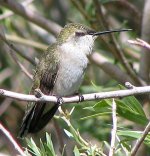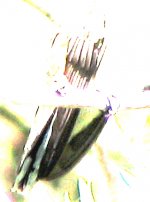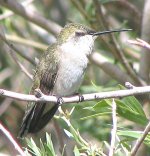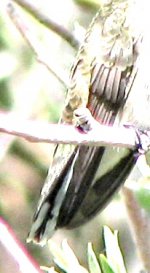-
Welcome to BirdForum, the internet's largest birding community with thousands of members from all over the world. The forums are dedicated to wild birds, birding, binoculars and equipment and all that goes with it.
Please register for an account to take part in the discussions in the forum, post your pictures in the gallery and more.
You are using an out of date browser. It may not display this or other websites correctly.
You should upgrade or use an alternative browser.
You should upgrade or use an alternative browser.
Female Hummingbird (1 Viewer)
- Thread starter maitreya
- Start date
More options
Who Replied?Katy Penland
Well-known member
Black-chinned juvenile (Archilochus alexandri), but I'm not sure this bird could yet be called male or female.
The long, slightly down-curved bill and the wings being just short of the tail are good for BCHU. Ruby-throat doesn't occur in the western US, the bill is way too long to be Anna's, the wings are too short for Costa's (not to mention that both Anna's and Costa's aren't found in eastern Oregon -- which is where I'm assuming Fields is, right? The southeast corner of the state?), and it's not green enough on the dorsal side nor have any hint of rufous on the flanks which would indicate a rufous juvie.
Nice photo, too!
The long, slightly down-curved bill and the wings being just short of the tail are good for BCHU. Ruby-throat doesn't occur in the western US, the bill is way too long to be Anna's, the wings are too short for Costa's (not to mention that both Anna's and Costa's aren't found in eastern Oregon -- which is where I'm assuming Fields is, right? The southeast corner of the state?), and it's not green enough on the dorsal side nor have any hint of rufous on the flanks which would indicate a rufous juvie.
Nice photo, too!
maitreya
Well-known member
Katy Penland said:Black-chinned juvenile (Archilochus alexandri), but I'm not sure this bird could yet be called male or female.
The long, slightly down-curved bill and the wings being just short of the tail are good for BCHU. Ruby-throat doesn't occur in the western US, the bill is way too long to be Anna's, the wings are too short for Costa's (not to mention that both Anna's and Costa's aren't found in eastern Oregon -- which is where I'm assuming Fields is, right? The southeast corner of the state?), and it's not green enough on the dorsal side nor have any hint of rufous on the flanks which would indicate a rufous juvie.
Nice photo, too!
I am told that Black Chinned Hummingbird has primary feathers that are shaped in a way that is diagnostic for the species and that this bird does not have them. See the enhanced image of the primaries.
Also, the first male Black-chinned Hummingbirds arrived at Fields on May 6 and the first females on May 9. This rules out this being a bird of this year from Fields. Alternatively, I suppose you could postulate that a post breeding dispersal bird from some Southern breeders could arrive within 14 days of the first adults, but that seems unrealistic to me.
Michael Frankis
conehead
I'll tentatively go for Anna's, even though that 'shouldn't' be so white below. Long tail relative to wing length, and lack of club-ended wing that Black-chinned would show.
Michael
Michael
Jane Turner
Well-known member
Total concensus then  I'll keep out of this, I had enough trouble with the males!
I'll keep out of this, I had enough trouble with the males!
Charles Harper
Régisseur
Awful, aren't they-- and they're so small too. I vote for Anna's. Don't think the bill (or beak) is long and curved enough for Black-chinned. Throat patches are notoriously variable (or absent) in females.
crispycreme
Well-known member
I'm just curious why people here are saying the tail is further out than the wingtips? I certainly can't tell that by the picture. The tip of the tail seems obscured by the wings.
Katy Penland
Well-known member
Hi, Matt,crispycreme said:I'm just curious why people here are saying the tail is further out than the wingtips? I certainly can't tell that by the picture. The tip of the tail seems obscured by the wings.
Here's the shot with the contrast bumped up a little so the drooping wings are a little more visible falling well short of the tail.
Unfortunately, from that really blown-out second image posted, I couldn't make out anything about the primaries, but I'll defer to everyone else about this being an Anna's even if it's way out of range (again, assuming that Fields, OR, is in the far southeast corner of OR). This bird just looks so much like the juvie black-chinneds we get here that the profile, coloration and stance are what registered to me. Having said that, new juvie hummers are damned difficult to ID even in person, much less from a photo, and you can see from the complete lack of any throat patterning whatsoever, this is a very, very new bird. I also think part of what is making this bird's bill (beak) appear shorter than some have assumed it should for Black-chinned is the bird being fluffed-up due to cold.
It's still a cutie, whatever it is. Love the hummers!
Attachments
crispycreme
Well-known member
Ahh, thanks, I see it now, Katy. It looked like the tip of the tail was part of the wing in the first pic. All I'll say is that is one "smooth shaven" chin for an Anna's at any age or gender. The ones around our house (and they are legion around here) virtually all have some splotchiness on their chins by the time they leave the nest.
maitreya
Well-known member
There are no records of Anna's Hummingbird at Fields. Anna's Hummingbirds are resident year round in the Willamette Valley of Oregon, and a very small number have wintered at Bend in Central Oregon. Generally speaking they seem to be established as a a non migratory population in Oregon, though there are vagrant records from many places all across North America.
Do all of you Anna's voters think this is an adult female in atypical plumage or a hatch year bird?
Do all of you Anna's voters think this is an adult female in atypical plumage or a hatch year bird?
Charles Harper
Régisseur
Do all of you Anna's voters think this is an adult female in atypical plumage or a hatch year bird?
I wouldn't use the word 'atypical'-- female's throat 'usually shows red flecks'. It's too early in the year for immatures, as someone mentioned. The photo on the left-- to me-- clearly shows the tail extending beyond the wings, and the wingtips (drooping below) are clearly not 'bulbous'-tipped (as in BCHU). Bill (or beak) is admittedly slightly longer and downer-curved than many illustrations, but is still closer to Anna's than any other. The 'white' above and behind the sleepy eye is faded, but I think still there. Ruby-throated is a better second-guess than BC, because of the bill (or beak) and forehead shape, but should appear brighter. The main question, though, may be whether indeed it is a juvenile or an adult.
Katy Penland
Well-known member
Even though I'm not one of the Anna's voters, I'd like to further respond anyway to a couple things mentioned by Charles and others.
Our black-chinneds and broad-taileds have already fledged their first brood and have left. We're in the "lull" between broods of these two spp, of which we usually get two per year. I don't know for certain if the rufous, which have yet to arrive, have ever fledged two clutches in a single season. So although we're southeast of southeast Oregon (I'm in northeast AZ), we're still at 7,000 ft. and have a similar "timetable" for breeding season as points farther north. So it may or may not be "too early" for immature BCHU to show up in southeast Oregon. As BCHU breeds throughout the western US from Mexico to Canada (except for extreme western OR, WA and northern CA), this bird in SE OR could be from anywhere and not from one of the Fields broods.
Ruby-throated hummingbirds do not occur west of the Rocky Mountains except for about a half-dozen records ever, and none of those are in Oregon (as far as I know -- someone please correct me).
Black-chinned's wings are not "bulbous" on the ends, they're simply broader and less delicate looking than most other hummer spp, and not tapered. But to characterize them as "bulbous" or "club-ended" on the ends is way over-stating the case. They may have that appearance in the hand with the wings spread out and each feather flattened, but they do not have that appearance perched or in flight. At least none of the hundreds we've had here in our back yard at the feeders and in the trees show this characteristic.
This bird also exhibits the exact description Sibley uses for BCHU juvies: "grayer crown and auriculars contrast less with throat" [than does Anna's, whose auriculars are darker gray and more contrasting to the throat]. Anna's is also much greener on the forehead and crown than BCHU; the bird in question has far more gray than green.
Of all the Anna's I'd seen over a 7-year period of birding in southern CA when I lived there, none of them (to my recollection) ever exhibited the slightest bit of curve to the bill. The bills were short and looked like little straightpins (if I may borrow a sewing notion).
I also meant to ask earlier if this bird's eye was "sleepy" or "weepy"? Does it look to anyone else like both upper and lower lids are slightly swollen and the squinty-eyed appearance is due to an irritation or infection of some kind? Perhaps I've been seeing too many house finches with infected eyes this year (for the first time) so I look for the boogey man everywhere now.
Sorry, but I just don't see anything to point to Anna's and everything to indicate BCHU. Okay, I'll shut up now and give the floor back to you Anna's voters.
Our black-chinneds and broad-taileds have already fledged their first brood and have left. We're in the "lull" between broods of these two spp, of which we usually get two per year. I don't know for certain if the rufous, which have yet to arrive, have ever fledged two clutches in a single season. So although we're southeast of southeast Oregon (I'm in northeast AZ), we're still at 7,000 ft. and have a similar "timetable" for breeding season as points farther north. So it may or may not be "too early" for immature BCHU to show up in southeast Oregon. As BCHU breeds throughout the western US from Mexico to Canada (except for extreme western OR, WA and northern CA), this bird in SE OR could be from anywhere and not from one of the Fields broods.
Ruby-throated hummingbirds do not occur west of the Rocky Mountains except for about a half-dozen records ever, and none of those are in Oregon (as far as I know -- someone please correct me).
Black-chinned's wings are not "bulbous" on the ends, they're simply broader and less delicate looking than most other hummer spp, and not tapered. But to characterize them as "bulbous" or "club-ended" on the ends is way over-stating the case. They may have that appearance in the hand with the wings spread out and each feather flattened, but they do not have that appearance perched or in flight. At least none of the hundreds we've had here in our back yard at the feeders and in the trees show this characteristic.
This bird also exhibits the exact description Sibley uses for BCHU juvies: "grayer crown and auriculars contrast less with throat" [than does Anna's, whose auriculars are darker gray and more contrasting to the throat]. Anna's is also much greener on the forehead and crown than BCHU; the bird in question has far more gray than green.
Of all the Anna's I'd seen over a 7-year period of birding in southern CA when I lived there, none of them (to my recollection) ever exhibited the slightest bit of curve to the bill. The bills were short and looked like little straightpins (if I may borrow a sewing notion).
I also meant to ask earlier if this bird's eye was "sleepy" or "weepy"? Does it look to anyone else like both upper and lower lids are slightly swollen and the squinty-eyed appearance is due to an irritation or infection of some kind? Perhaps I've been seeing too many house finches with infected eyes this year (for the first time) so I look for the boogey man everywhere now.
Sorry, but I just don't see anything to point to Anna's and everything to indicate BCHU. Okay, I'll shut up now and give the floor back to you Anna's voters.
Dave B Smith
Well-known member
This has been a great thread and very informative. I have very little experience with Black-chinned Hummingbirds with only several sightings of each, male and female. I do have plenty of experience with Ruby-throated Hummingbirds though and would like to add this.
First as Katy has mentioned there have been very very few sightings of Ruby-throated Hummingbirds in the west. Secondly, a female Black-chinned cannot safely be told from a female Ruby-throated except in the hand (from Patuxtent Bird Identification center). So female Ruby-throated HAS to be ruled out because there is no way from just this photo to positively ID it as such.
So, since the photo looks very much like the female (or juvenile) Ruby-throated but is in Oregon, I'm going to vote with Katy for Black-chinned.
First as Katy has mentioned there have been very very few sightings of Ruby-throated Hummingbirds in the west. Secondly, a female Black-chinned cannot safely be told from a female Ruby-throated except in the hand (from Patuxtent Bird Identification center). So female Ruby-throated HAS to be ruled out because there is no way from just this photo to positively ID it as such.
So, since the photo looks very much like the female (or juvenile) Ruby-throated but is in Oregon, I'm going to vote with Katy for Black-chinned.
Charles Harper
Régisseur
Thanks Katy. You're the one with hands-on experience, I'm just sitting here learning to use my Sibley. As you know, but for 4 days in San Diego, I haven't seen a North American bird in the feather for 15 years!
By the way, what did the BirdChat folks have to say, maitreya?
By the way, what did the BirdChat folks have to say, maitreya?
Katy Penland
Well-known member
Well, hie thee back here! The birds miss you. :bounce:Charles Harper said:Thanks Katy. You're the one with hands-on experience, I'm just sitting here learning to use my Sibley. As you know, but for 4 days in San Diego, I haven't seen a North American bird in the feather for 15 years!
maitreya
Well-known member
Katy Penland said:Even though I'm not one of the Anna's voters, I'd like to further respond anyway to a couple things mentioned by Charles and others.
Our black-chinneds and broad-taileds have already fledged their first brood and have left. We're in the "lull" between broods of these two spp, of which we usually get two per year. I don't know for certain if the rufous, which have yet to arrive, have ever fledged two clutches in a single season. So although we're southeast of southeast Oregon (I'm in northeast AZ), we're still at 7,000 ft. and have a similar "timetable" for breeding season as points farther north. So it may or may not be "too early" for immature BCHU to show up in southeast Oregon. As BCHU breeds throughout the western US from Mexico to Canada (except for extreme western OR, WA and northern CA), this bird in SE OR could be from anywhere and not from one of the Fields broods.
As I mentioned, I think it is unrealistic to think that a hatch year Black-chinned Hummingbird could arrive here within 14 days of the first adult females. In my ten year experience of birding fields. I have never seen a juvenile hummingbird of any species during May. So, it would be a far more novel event for a juvenile hummingbird of any species to occur at Fields than it would for an eastern vagrant to occur at Fields. I am aware of hundreds of such records of eastern vagrants at Fields during May.
Ruby-throated hummingbirds do not occur west of the Rocky Mountains except for about a half-dozen records ever, and none of those are in Oregon (as far as I know -- someone please correct me).
I am aware of ten records in California alone. This bird will probably be submitted for the first record in Oregon.
Black-chinned's wings are not "bulbous" on the ends, they're simply broader and less delicate looking than most other hummer spp, and not tapered.
This is not exactly right. The primaries of Black-chinned Hummingbird get wider as you move towards the distal end. It is clear to me that the primaries of the bird in the photo do not get wider toward the distal end.
I have attached my latest enhancement of the primaries made with different image processing software.
But to characterize them as "bulbous" or "club-ended" on the ends is way over-stating the case. They may have that appearance in the hand with the wings spread out and each feather flattened, but they do not have that appearance perched or in flight. At least none of the hundreds we've had here in our back yard at the feeders and in the trees show this characteristic.
In the last ten years, I have also studied hundreds of Black-chinned Hummingbirds with my 8x32 SE bins at close range at my feeders and in the local Willow and Buffalo Berry thickets. I have seen this feature of the primaries in perched birds. Further, I have never seen an adult Black-chinned Hummingbird with a bill this straight, this thick, and this short.
Sorry, but I just don't see anything to point to Anna's and everything to indicate BCHU. Okay, I'll shut up now and give the floor back to you Anna's voters.
I agree that it is not Anna's or Costa's. In the last ten years I have observed hundreds of Black-chinned Hummingbirds during spring migration at Fields. I do not believe this is one.
Attachments
Dave B Smith
Well-known member
Maitreya,
Good luck with your submittal. I agree it looks good for a female Ruby-throated but as I mentioned earlier, without having the bird in hand, or having a clear voice description, it is very hard to distinguish them from the Black-chinned in the field. I think it will be hard to get it accepted since it is so far out of range on just the basis of the photo.
Do let us know. As you can see, there are lots of folks who would like to know for sure what it is!
Good luck with your submittal. I agree it looks good for a female Ruby-throated but as I mentioned earlier, without having the bird in hand, or having a clear voice description, it is very hard to distinguish them from the Black-chinned in the field. I think it will be hard to get it accepted since it is so far out of range on just the basis of the photo.
Do let us know. As you can see, there are lots of folks who would like to know for sure what it is!
Users who are viewing this thread
Total: 2 (members: 0, guests: 2)







